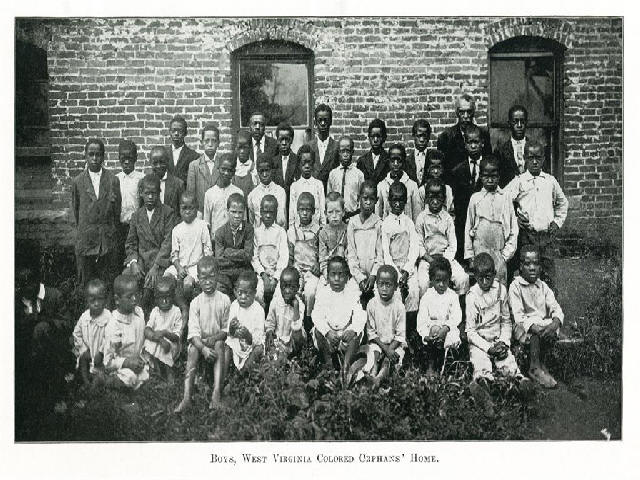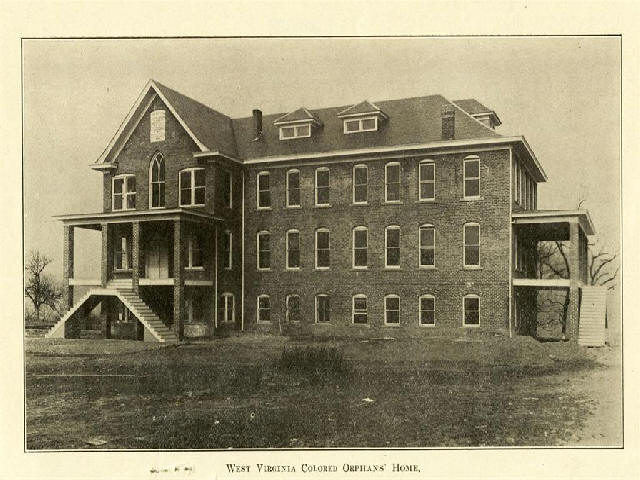
------------------------------------------------------------------------------------------------------
The location of the Huntington East Middle School was
once the site of an imposing brick building
that served as the West
Virginia Colored Orphans' Home.
Established in 1899,and rebuilt in 1923
following a fire, the West
Virginia Colored Orphans' Home was an important Huntington
institution
created by and for African Americans to care for some of the most
vulnerable members of the community during a period of racial
segregation.
The Colored Orphans' Home was closed in 1956 when
orphan care integrated in West Virginia,
and the building served many
different functions through the ensuing decades. Following
demolition of
the building in 2011 to make way for the new middle school,
Cabell County Schools created a website to serve as a permanent
public
record of the Home that honors the memories of the children
who once lived there and encourages appreciation of
the county's rich African
American history.
------------------------------------------------------------------------------------------------------
History
Reverend Charles McGhee established the West Virginia Normal and
Industrial School for Colored Children in 1899.
Serving as superintendent from 1900 to 1915, Reverend McGhee purchased 210
acres along Norway Avenue in
1903-1904. A three-story brick building was built, partially with labor
from the School’s children. The state
supplemented the facility’s operating funds from 1903 to 1910, before
enacting legislation in 1911
establishing the West Virginia Colored Orphans’ Home and purchasing 190
acres and the
School’s main building. The purpose of the facility was to provide a home,
education, and vocational skills to African American children.

Over the years, children under sixteen years old were placed
in the home by social agencies, parents,
and relatives that could no longer afford to care for them. Girls were taught
sewing, cooking,
cleaning, and laundry skills, typical jobs available to African American women
in the
first half of the twentieth century. Boys were taught construction and
agricultural
skills at the facility. Minimal educational opportunities were provided in
the
early years of the institution, as discrimination and segregation limited the
institution's funding. Children were placed in foster homes and,
if found amenable to both parties, could be adopted.
All children worked in the gardens and orchards to supplement
their meals, with the boys
conducting the more labor intensive farm efforts, such as dealing with
livestock
(hogs, dairy, and beef cattle), planting, and harvesting, while the
girls focused on canning the orchard and garden products.

On April 5, 1920, the main building was destroyed by a fire
and the children were placed in various homes
and institutions until the newly constructed three-story, Classical
Revival-style brick building
opened in December 1923. The State Industrial Home for Colored Girls, a
state-operated
facility, opened in 1926 on land owned by the Orphans' Home south of
Norway Avenue.
In May 1928, the Orphans' Home was comprised of the main building, a garage,
the farm manager dwelling, a barn, a silo, a water tower,
a granary, and chicken and hog houses.
In 1931, the Orphans' Home was renamed the West Virginia
Colored Children's Home.
By 1951, classes were no longer taught at the facility. At
this time African American and white
educational facilities were separate, and the students were bused to segregated
African
American schools in Huntington, including Douglass High School. During this
period
the residents of the Children's Home attended church services, went to movie
theaters, and took part in activities at schools and social centers.
The 1954 U.S. Supreme Court ruling in Brown vs. Board of
Education legally ended segregated educational
facilities throughout the nation. Desegregation of schools did not occur
uniformly in all the states
that practiced segregation. The West Virginia Colored Children's Home operated
until 1956,
when the institution was closed and the residents of the Children's Home
were removed to
the newly integrated Children's Home at Elkins. After its closure, the
Huntington facility
briefly served as a nursing home named the West Virginia Home for the Aged and
Infirm Colored Men and Women. The institution and its grounds were
transferred
in 1961 to Marshall University and were re-purposed as housing for students.
In 1997, the Home was listed in the
National Register of Historic Places
for its significance as the "physical representation of the institution's
longstanding role in the provision of social services and education
to the state's black community" and for the Home's "design as a
Classical Revival-style institutional building
constructed 1922-23."
------------------------------------------------------------------------------------------------------
[ Next ]


